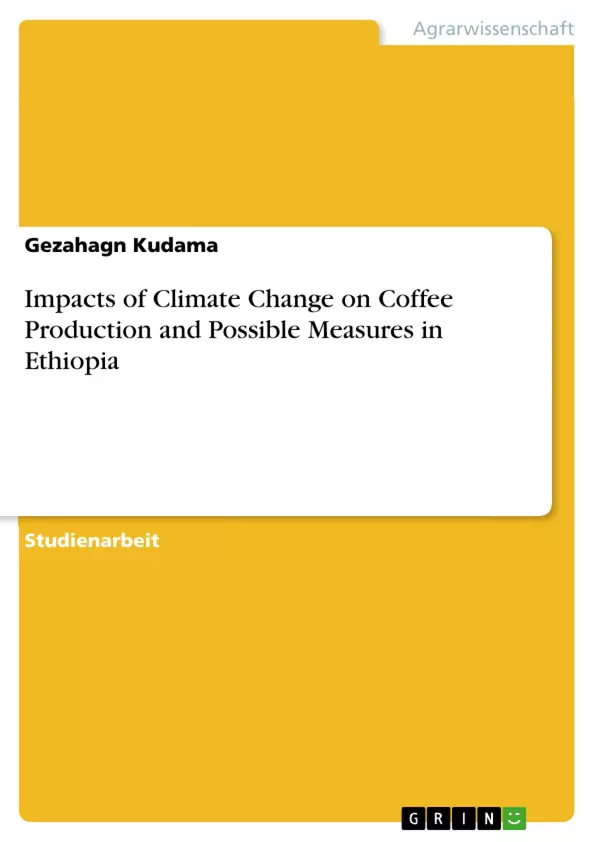This paper reviews that the impacts of climate change on coffee production and potential adaptation measures in coffee sub-sector in Ethiopia. Accordingly, Ethiopian coffee industry is potentially at risk due to the negative impact of climate change on suitability of coffee production. Climate change been severely affecting the national income of the country in general and the livelihoods of poor smallholders in particular via undermining coffee yield and quality.
Furthermore, several studies predicted that will continue to impact coffee production in the future. Accordingly, a policy measure that enforces and promotes irrigation, mulching, pruning, tree shade management, drought, pests and diseases resistant high yield improved coffee variety development for coffee production is paramount ISBN: 9783346111074
Inhaltsverzeichnis
- Kapitel Eins: Einleitung
- 1.1 Hintergrund
- 1.2 Ziele des Seminars
- Kapitel Zwei: Materialien und Methoden
Zielsetzung und Themenschwerpunkte
Dieses Seminarpapier untersucht die Auswirkungen des Klimawandels auf den Kaffeeanbau in Äthiopien und mögliche Anpassungsmaßnahmen. Es zielt darauf ab, die Risiken des Klimawandels für die äthiopische Kaffeeindustrie aufzuzeigen und potenzielle Lösungen vorzustellen.
- Auswirkungen des Klimawandels auf den Kaffeeanbau in Äthiopien
- Anfälligkeit der äthiopischen Kaffeeindustrie gegenüber dem Klimawandel
- Potenzielle Anpassungs- und Bewältigungsstrategien
- Wirtschaftliche und soziale Bedeutung des Kaffees für Äthiopien
- Notwendige politische Maßnahmen zur Sicherung der Kaffeeindustrie
Zusammenfassung der Kapitel
Kapitel Eins: Einleitung: Dieses Kapitel liefert einen umfassenden Überblick über die globale Bedeutung des Kaffees, insbesondere für Äthiopien als führenden Produzenten. Es beleuchtet die wirtschaftliche Bedeutung des Kaffees für das Land und die Abhängigkeit Millionen von Kleinbauern von diesem Erwerbszweig. Darüber hinaus wird der Begriff des Klimawandels definiert und dessen negative Auswirkungen auf die Kaffee-Produktion weltweit und speziell in Äthiopien erläutert. Das Kapitel betont die Dringlichkeit, Anpassungsstrategien zu entwickeln, um die zukünftige Nachhaltigkeit der Kaffeeindustrie zu sichern. Die zunehmenden Temperaturen, der Anstieg von Schädlingen und Krankheiten sowie der Rückgang geeigneter Anbauflächen werden als konkrete Bedrohungen dargestellt. Die Notwendigkeit von Anpassungsmaßnahmen wird im Kontext der wirtschaftlichen und sozialen Bedeutung des Kaffees für Äthiopien hervorgehoben.
Kapitel Zwei: Materialien und Methoden: Dieses Kapitel beschreibt die Methodik der vorliegenden Seminararbeit. Da es sich um ein Literaturreview handelt, basiert die Arbeit ausschließlich auf Sekundärdaten aus verschiedenen Veröffentlichungen wie Fachzeitschriften, Berichten und Dissertationen. Es wird darauf hingewiesen, dass keine spezifischen Methoden außer der systematischen und chronologischen Zusammenstellung der gesammelten Informationen angewendet wurden.
Schlüsselwörter
Klimawandel, Kaffeeanbau, Äthiopien, Arabica-Kaffee, Anpassungsmaßnahmen, Kleinbauern, Wirtschaft, Nachhaltigkeit, Risikomanagement, Landwirtschaft.
Häufig gestellte Fragen zum Seminarpapier: Auswirkungen des Klimawandels auf den Kaffeeanbau in Äthiopien
Was ist der Gegenstand dieses Seminarpapiers?
Dieses Seminarpapier untersucht die Auswirkungen des Klimawandels auf den Kaffeeanbau in Äthiopien und mögliche Anpassungsmaßnahmen. Es beleuchtet die Risiken für die äthiopische Kaffeeindustrie und präsentiert potenzielle Lösungen.
Welche Themen werden im Seminarpapier behandelt?
Die zentralen Themen sind: Auswirkungen des Klimawandels auf den Kaffeeanbau in Äthiopien, die Anfälligkeit der äthiopischen Kaffeeindustrie, potenzielle Anpassungs- und Bewältigungsstrategien, die wirtschaftliche und soziale Bedeutung des Kaffees für Äthiopien und notwendige politische Maßnahmen zur Sicherung der Kaffeeindustrie.
Welche Kapitel umfasst das Seminarpapier?
Das Seminarpapier besteht aus mindestens zwei Kapiteln: Kapitel Eins (Einleitung) und Kapitel Zwei (Materialien und Methoden). Kapitel Eins bietet einen Überblick über die globale Bedeutung des Kaffees, insbesondere für Äthiopien, die wirtschaftliche Bedeutung und die Abhängigkeit der Kleinbauern. Es definiert den Klimawandel und dessen negative Auswirkungen auf die Kaffee-Produktion. Kapitel Zwei beschreibt die Methodik, die auf einem Literaturreview basierend auf Sekundärdaten beruht.
Wie lautet die Methodik des Seminarpapiers?
Das Seminarpapier basiert auf einem Literaturreview. Die Arbeit verwendet Sekundärdaten aus Fachzeitschriften, Berichten und Dissertationen. Es werden keine spezifischen Methoden außer der systematischen und chronologischen Zusammenstellung der gesammelten Informationen angewendet.
Welche Schlüsselwörter beschreiben das Seminarpapier?
Schlüsselwörter sind: Klimawandel, Kaffeeanbau, Äthiopien, Arabica-Kaffee, Anpassungsmaßnahmen, Kleinbauern, Wirtschaft, Nachhaltigkeit, Risikomanagement, Landwirtschaft.
Welche Ziele verfolgt das Seminarpapier?
Das Seminarpapier zielt darauf ab, die Risiken des Klimawandels für die äthiopische Kaffeeindustrie aufzuzeigen und potenzielle Lösungen vorzustellen. Es soll einen umfassenden Einblick in die Problematik und mögliche Lösungsansätze liefern.
Welche konkreten Bedrohungen durch den Klimawandel werden für den äthiopischen Kaffeeanbau genannt?
Konkrete Bedrohungen sind steigende Temperaturen, der Anstieg von Schädlingen und Krankheiten sowie der Rückgang geeigneter Anbauflächen.
- Citar trabajo
- Gezahagn Kudama (Autor), 2019, Impacts of Climate Change on Coffee Production and Possible Measures in Ethiopia, Múnich, GRIN Verlag, https://www.grin.com/document/512859



